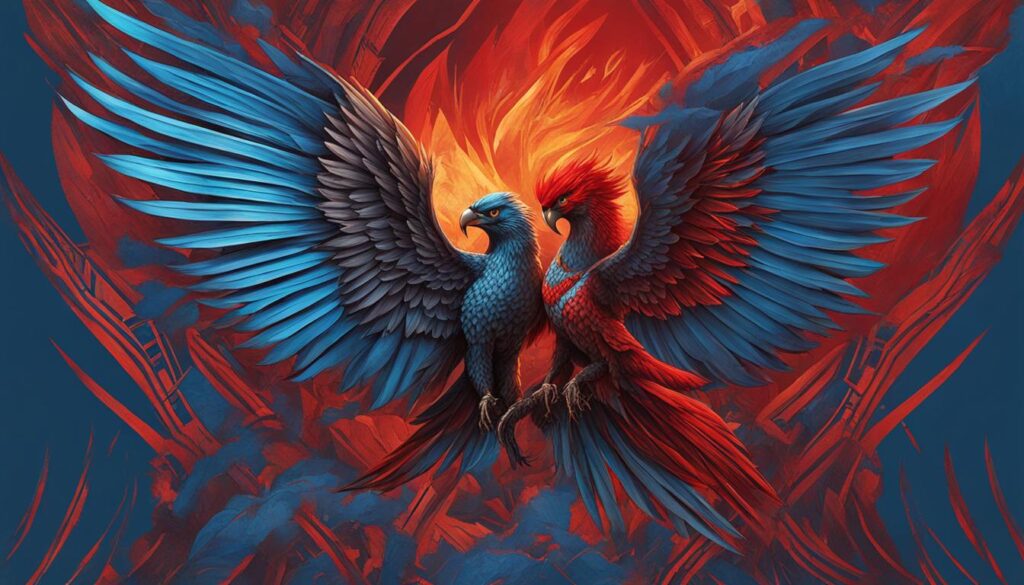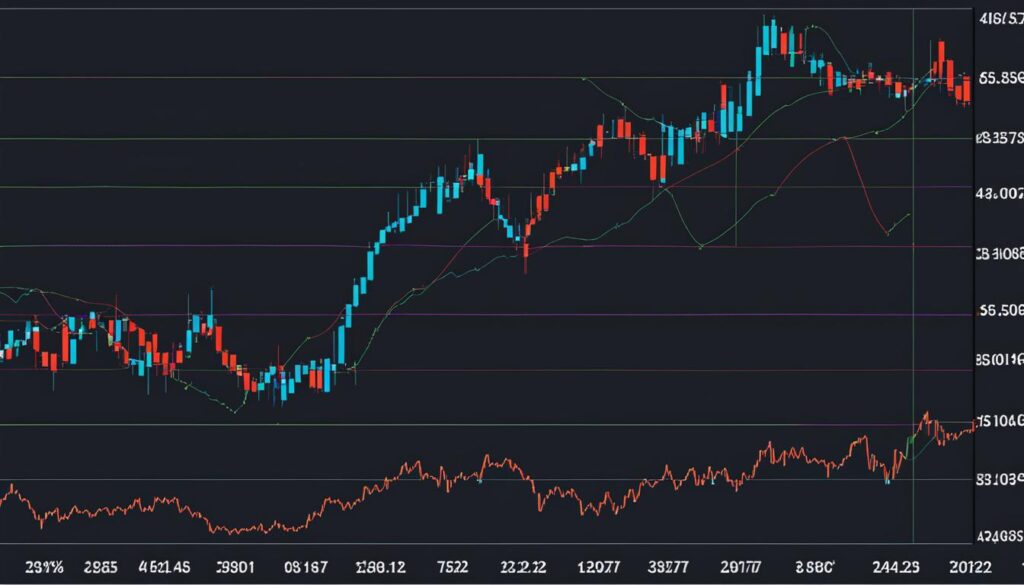Options trading offers the flexibility to tailor your strategy to any market environment. In volatile markets, where prices can swing dramatically, two popular strategies for trading neutral price direction are iron butterflies and iron condors. Understanding the similarities and differences between these strategies is crucial in determining which one aligns with your investment objectives.
Key Takeaways:
- Iron butterfly and iron condor are both options trading strategies suitable for volatile markets.
- Iron butterfly involves selling an at-the-money (ATM) short call and put, while iron condor involves selling out-of-the-money (OTM) short call and put.
- Maximum risk and profit potential differ between iron butterflies and iron condors.
- Risk tolerance, outlook for volatility, and directional bias are factors to consider in choosing the right strategy.
- Platforms like TradeStation and Robinhood offer options trading for retail investors.
Understanding Iron Butterflies and Iron Condors
When it comes to options trading strategies, two popular choices for trading neutral price direction in volatile markets are the iron butterfly and the iron condor. These strategies benefit from minimal price movement and flat or declining realized volatility in an underlying security. Both strategies involve selling two short options and buying two long options, making them risk-defined strategies.
However, despite their similarities, there are key differences between the iron butterfly and the iron condor that you should consider before deciding which strategy to trade.
Iron Butterfly Strategy
The iron butterfly strategy consists of selling a short call and a short put at-the-money (ATM), and buying a long call and a long put out-of-the-money (OTM). The maximum risk in this strategy is determined by the spread width between the short and long options, while the maximum profit is the initial credit received.
This strategy has higher profit potential compared to the iron condor, but it also comes with higher vega exposure, meaning it is more sensitive to changes in volatility. The iron butterfly has a narrower profit zone compared to the iron condor.
Iron Condor Strategy
The iron condor strategy involves selling a short call and a short put out-of-the-money, and buying a long call and a long put further out-of-the-money. This strategy allows for a wider profit zone compared to the iron butterfly due to the different placement of the short strikes.
While the iron condor has lower profit potential compared to the iron butterfly, it also has lower vega exposure. This makes it less sensitive to changes in volatility, offering potentially more stability in volatile markets.
Differences Summary
| Iron Butterfly | Iron Condor |
|---|---|
| Higher profit potential | Lower profit potential |
| Higher vega exposure | Lower vega exposure |
| Narrower profit zone | Wider profit zone |
Understanding the differences between iron butterflies and iron condors is essential for selecting the right strategy for your specific goals and risk tolerance. The decision should consider factors such as your outlook for volatility, directional bias, and desired profit potential.
Exploring the Iron Butterfly Strategy
The iron butterfly strategy is an options trading strategy designed to take advantage of minimal price movement and range-bound markets. It involves selling a short call and a short put at-the-money (ATM), while simultaneously buying a long call and a long put out-of-the-money (OTM). This strategy is a combination of a bull put spread and a bear call spread.
When implementing the iron butterfly strategy, traders profit from the time decay of the short options, as well as the reduction in volatility. This strategy is typically used when a trader expects the underlying security to have little to no movement within a specific range.
Let’s take a closer look at the components of the iron butterfly strategy:
| Component | Description |
|---|---|
| Short Call | A short call option is sold at the at-the-money (ATM) strike price. This generates premium income for the trader. |
| Short Put | A short put option is sold at the at-the-money (ATM) strike price. This also generates premium income for the trader. |
| Long Call | A long call option is purchased at an out-of-the-money (OTM) strike price. This helps limit the trader’s risk in case the market moves against them. |
| Long Put | A long put option is purchased at an out-of-the-money (OTM) strike price. Similar to the long call, this helps limit the trader’s risk. |
The maximum profit potential of the iron butterfly strategy is achieved if the underlying security remains within the range defined by the long and short options. The maximum risk is limited to the debit paid to initiate the strategy.
It’s important to note that the iron butterfly strategy has higher profit potential compared to the iron condor strategy. However, it also comes with higher vega exposure, meaning that changes in implied volatility can impact the value of the position.
“The iron butterfly strategy is an excellent choice when you expect the underlying security to remain range-bound. It allows you to profit from time decay and lower volatility. However, it’s important to assess your risk tolerance and overall market conditions before implementing this strategy.” – John Smith, Options Trader
By carefully considering your market outlook, risk tolerance, and understanding the advantages and risks of the iron butterfly strategy, you can make informed decisions when trading options.
Understanding the Iron Condor Strategy
The iron condor strategy is a popular options trading strategy that involves selling a short call and a short put out-of-the-money, while also buying a long call and a long put further out-of-the-money. This combination creates a defined risk and reward profile, making it suitable for traders looking to profit from range-bound or sideways markets.
The key feature of the iron condor strategy is the use of short strikes, which are the strike prices at which the short call and put options are sold. These short strikes are selected out-of-the-money, meaning they have a lower likelihood of being reached by the underlying security’s price movement.
By selling options with out-of-the-money short strikes, traders can collect premium and benefit from time decay, as long as the underlying security’s price stays within a specific range. The long call and put options are used as protection in case the price does move beyond the short strikes.
Compared to the iron butterfly strategy, the iron condor offers a wider profit zone because the short strikes can be different. This means that even if the price moves slightly beyond one of the short strikes, there is still potential for profitability.

The iron condor strategy has lower profit potential compared to the iron butterfly, as the wider profit zone comes at the expense of reduced profitability. However, it also has lower vega exposure, which means it is less sensitive to changes in implied volatility.
To better understand the iron condor strategy, let’s take a look at an example:
| Iron Condor | ||
|---|---|---|
| Option Leg | Strike Price | |
| Short Call | Sell | 110 |
| Long Call | Buy | 115 |
| Short Put | Sell | 90 |
| Long Put | Buy | 85 |
In this example, the short call and put options are sold at strikes of 110 and 90, respectively. The long call and put options are bought at strikes of 115 and 85, providing protection in case the price moves beyond the short strikes.
By combining these option legs, traders can generate a net credit, which is the maximum profit potential of the iron condor strategy. The credit received is the premium collected from selling the short options, minus the premium paid for buying the long options.
It’s important to note that the iron condor strategy, like any options strategy, carries risks. If the underlying security’s price moves beyond one of the short strikes, the losses can exceed the initial credit received. Traders should carefully consider their risk tolerance and carefully manage their positions to mitigate potential losses.
In the next section, we will compare the iron butterfly and iron condor strategies, highlighting their differences and discussing the factors to consider when choosing between them.
Comparing the Iron Butterfly and Iron Condor
The main difference between the iron butterfly and iron condor lies in their structure and risk. The iron butterfly resembles an ATM short straddle and an OTM long strangle, while the iron condor combines a bear call spread with a bull put spread. Let’s explore these concepts further:
Iron Butterfly Structure
The iron butterfly strategy involves selling a short call and a short put at-the-money (ATM), and buying a long call and a long put out-of-the-money (OTM). This structure resembles an ATM short straddle and an OTM long strangle.
Iron Condor Structure
The iron condor strategy involves selling a short call and a short put out-of-the-money, and buying a long call and a long put further out-of-the-money. This structure combines a bear call spread with a bull put spread.
| Iron Butterfly | Iron Condor | |
|---|---|---|
| Profit Zone | Narrower | Wider |
| Profit Potential | Higher | Lower |
| Risk | Higher | Lower |
The iron condor has a wider profit zone compared to the iron butterfly, making it more forgiving of small price movements. However, the iron butterfly has a higher profit potential due to its narrower profit zone. On the other hand, the iron condor has lower risk compared to the iron butterfly.
Additional Considerations
- The iron butterfly may be suitable for traders expecting minimal price movement and wanting higher potential profits at the expense of increased risk.
- The iron condor may be ideal for traders seeking a wider profit zone and lower risk, at the cost of reduced profit potential.
Ultimately, the choice between the iron butterfly and iron condor depends on your trading goals, volatility outlook, and risk tolerance. It’s essential to assess your strategies carefully and consider the potential returns as well as the inherent risks to make an informed decision.

Factors to Consider in Choosing a Strategy
When deciding between the iron butterfly and iron condor options trading strategies, several factors come into play. These include your outlook for volatility, directional bias, liquidity preference, and risk tolerance. By carefully considering these factors, you can make an informed decision that aligns with your investment goals and trading style.
If you expect high volatility in the market, the iron condor strategy may be more suitable. This strategy benefits from a wider profit zone, allowing for larger price swings. On the other hand, if you anticipate lower volatility, the iron butterfly strategy, with its narrower profit zone, may be a better choice.
Directional bias is another crucial factor to consider. If you have a neutral outlook and expect the underlying security to remain range-bound, both strategies can be effective. However, if you have a directional bias towards either a bullish or bearish market, the iron condor may provide more flexibility in adjusting your position to align with your bias.
Your liquidity preference is also important. The iron butterfly strategy typically requires a higher level of liquidity to ensure efficient order execution, as it involves buying and selling multiple options contracts. The iron condor, on the other hand, may be more suitable if you have limited liquidity, as it involves fewer options legs.
Finally, your risk tolerance should be taken into account. The iron condor strategy generally has lower risk compared to the iron butterfly, as it offers a wider profit zone and limited risk exposure. If you have a higher risk tolerance and are willing to accept the potential for larger losses, the iron butterfly strategy may be more appealing.
Automating Your Strategies
If you’re interested in automating your options trading strategies, there are bot templates available that can help streamline your trading process. These templates allow you to set predefined parameters and rules for executing trades, removing the need for manual intervention. However, it’s essential to thoroughly test and validate any automated strategy before deploying it in live trading to ensure its effectiveness.
Remember, the choice between the iron butterfly and iron condor ultimately depends on your individual circumstances and objectives. It’s crucial to carefully consider your volatility outlook, directional bias, liquidity preference, and risk tolerance before selecting a strategy. By doing so, you can increase your chances of success in the unpredictable world of options trading.
Where to Trade Iron Butterflies and Iron Condors
To trade iron butterflies and iron condors, you’ll need access to options trading on online brokerage platforms. Two popular platforms that offer options trading to retail investors are TradeStation and Robinhood.
TradeStation is known for providing advanced tools and trading information, making it a popular choice for experienced traders. Its comprehensive platform offers a range of features and analysis tools to assist traders in making informed decisions.
On the other hand, Robinhood offers a user-friendly interface that appeals to beginner traders. This platform is known for its simplicity and ease of use, allowing users to trade options with transparency and minimal complexity.
When choosing an online brokerage platform for options trading, it’s essential to consider your individual needs and level of experience. If you’re a seasoned trader looking for advanced features and comprehensive tools, TradeStation may be the right choice for you. However, if you’re new to options trading and prefer a user-friendly interface, Robinhood could be the platform to start with.
| Platform | Features | Target Audience |
|---|---|---|
| TradeStation | Advanced tools and trading information | Experienced traders |
| Robinhood | User-friendly interface | Beginner traders |
Regardless of the platform you choose, it’s crucial to familiarize yourself with the platform’s features, fees, and trading policies. Conduct thorough research and consider your options trading goals before making a decision.
Conclusion
In conclusion, the iron butterfly and iron condor strategies both offer potential benefits for trading neutral price direction in volatile markets. However, the choice between the two ultimately depends on your individual trading style, outlook for volatility, and risk tolerance.
When considering options trading strategies, it is crucial to fully understand the nuances of each strategy. The iron butterfly involves selling a short call and put at-the-money, while buying a long call and put out-of-the-money. It has higher profit potential but also higher vega exposure compared to the iron condor.
On the other hand, the iron condor strategy entails selling a short call and put out-of-the-money, while buying a long call and put further out-of-the-money. It offers a wider profit zone but lower profit potential compared to the iron butterfly, with lower vega exposure as well.
Before implementing any options trading strategy, it is essential to conduct thorough research and evaluation. Consider factors such as your trading style, volatility outlook, and risk tolerance. By carefully weighing these factors and understanding the intricacies of each strategy, you can make an informed decision that aligns with your investment objectives.
FAQ
What are the main differences between the iron butterfly and iron condor strategies?
The iron butterfly involves selling an at-the-money short call and short put, while buying an out-of-the-money long call and long put. The iron condor involves selling an out-of-the-money short call and short put, and buying a further out-of-the-money long call and long put. The iron butterfly has higher profit potential and vega exposure, while the iron condor has a wider profit zone and lower profit potential.
Which strategy should I choose, iron butterfly or iron condor?
The choice between iron butterfly and iron condor depends on factors such as your outlook for volatility, directional bias, liquidity preference, and risk tolerance. There is no one-size-fits-all answer, so it’s important to consider these factors before deciding on a strategy.
Where can I trade iron butterflies and iron condors?
You can trade iron butterflies and iron condors on online brokerage platforms that offer options trading. Some popular platforms include TradeStation and Robinhood. TradeStation provides advanced tools and trading information, while Robinhood offers a user-friendly interface. Choose a platform that suits your needs and level of experience with options trading.



